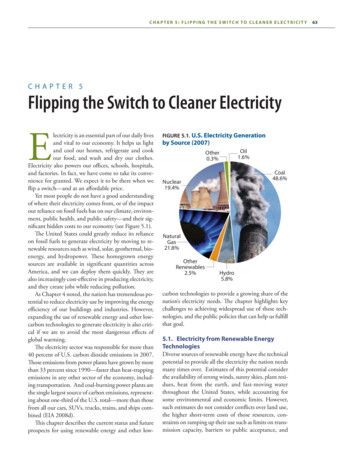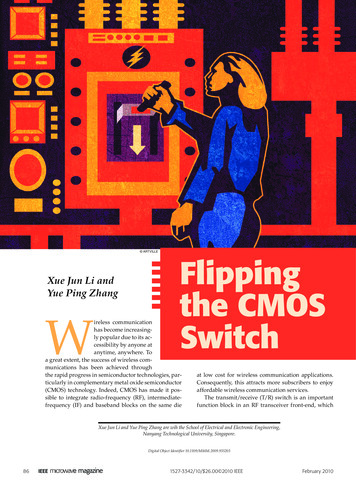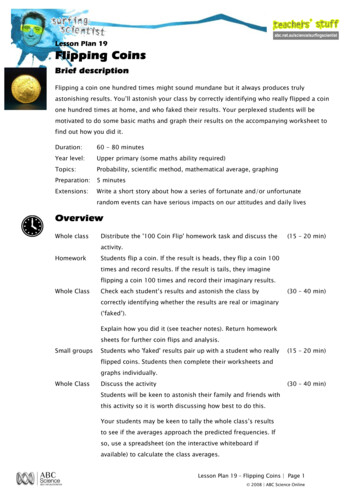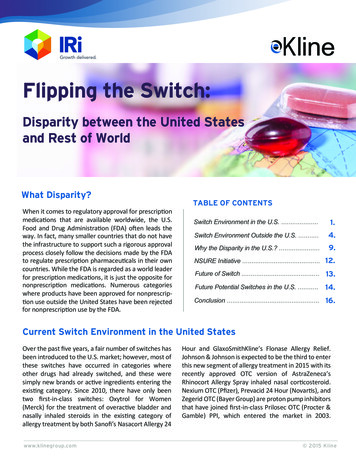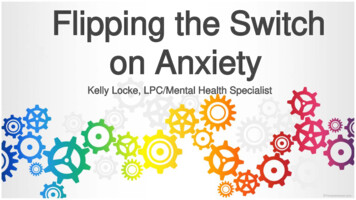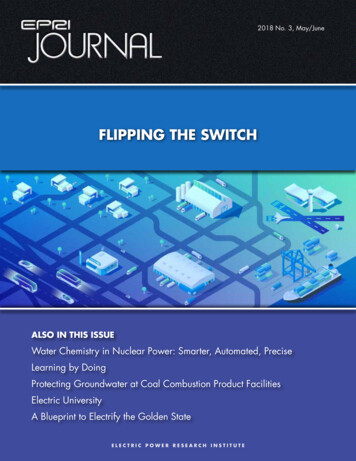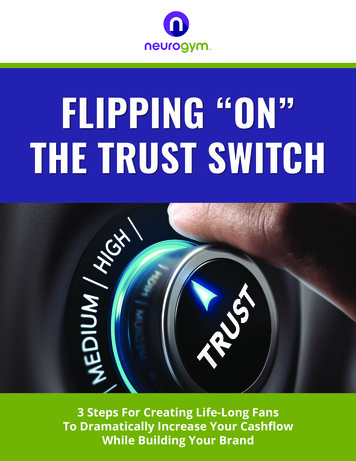
Transcription
FLIPPING “ON”THE TRUST SWITCH3 Steps For Creating Life-Long FansTo Dramatically Increase Your CashflowWhile Building Your Brand
Flipping “On” The Trust SwitchFlipping “On” the Trust SwitchIf you are a business owner who would like to find a predictable method to increase yourprofitability and cashflow to build long-term trust and loyalty while still having effectivemarketing that brings you a good return Then this book you’re about to read will be of intense interest to you. The new neuroscience“hacks” for creating immediate trust with your customers could change the course of yourbusiness forever.Here’s why In the pages of this report you’re going to learn the elements of creating a powerful brand thatattracts “die-hard fans”.You’ll learn the single most important number you must focus on to survive in the long-term.(Most business owners never think about this let alone track it your competition included just understanding this concept will give you a massive competitive advantage)You’ll find out how to use the oldest form of communication to release powerfulneurotransmitters in your prospect’s brains. These neurotransmitters will compel customers totrust you, and buy from you again and again and love it.And you’ll discover the mistake most businesses make that completely destroys theirrelationship with their customers. (And how you can avoid it)Finally, you will see why most business owners never have the courage to truly become anindustry leader. (To avoid having a “boring” and “heartless” corporation you need to know this)Sound interesting?Well, buckle up!Because you’re about to discover new neuroscience previously reserved forscientists and billion dollar companies with deep pockets But first, I have to ask you a question 2016 NeuroGym. All rights reserved.2
Flipping “On” The Trust SwitchDo You Have The Courage To Dream Big?As brutal as the business battlefield can be, the greatest struggle happens between your ears.When you read this report you’ll see how to position your business as an industry leader, with amission and vision that will inspire your prospects to take massive action.This information, in the right hands, can be EXTREMELY profitable.In fact, we had one client recently share this testimonial in our Facebook group:I’m proud of Sharon because she is now living her dream. 2016 NeuroGym. All rights reserved.3
Flipping “On” The Trust SwitchBut I’m not surprised.Because we have DOZENS of success stories just like that.Including this one, from another jewelry business:“THANK YOU - THANK YOU - THANK YOU!”Wow, last month I gave myself a fun goal of doubling my monthly business, which on a goodmonth was 55,000. Well, we came close 110,000 in sales!!! Now I set a goal of 150,000 forJune (and June is slow).I thought – I can’t possibly do that, but I just started in on it anyway, doing what Ineeded to do and we did 50,000 in a single day!— Erin MacGeraghty, Custom Jewelry DesignerIf I did share dozens of stories just like that you would notice a common thread.The first step in achieving your dream, is to believe that it’s possible.What exactly does that mean?Well, let me share a quick story with you.In our live Cloning Of Business Success event we had a gentleman who had a rather “boring”business. He had been chugging along, with the same profits for years. Not experiencingmassive growth, but not taking a hit either. He was content.And he was comfortable. But he wanted to grow. So I asked him at the event: “Is it possible totriple your business in a year?”He said it was impossible.Then, I asked him a different question. I said: “Who would you have to partner with, to triple yourbusiness in a year?”Again, he told me that it was impossible. (And he seemed a little annoyed by my questions)So I reframed it one more time, I said: “If Bill Gates wanted to partner with you, could you tripleyour business in a year?” 2016 NeuroGym. All rights reserved.4
Flipping “On” The Trust SwitchA lightbulb went off. He suddenly realized he COULD triple his business, all he had to do wasfind the right road to get there. The main reason he wasn’t his fear and admit that it was evenpossible though.So, my question to you is, do you have that courage?If you just felt a flash of panic, don’t worry about that. I’ll show youhow to remove that fear response and “re-train your brain” lateron For now, just sit with that question.Dig down to your core, and ask do I have the courage to set my dreams free?Step One: Track The Right NumberYou already know that the goal of a marketing campaign is to get apositive return.You want to put 1 in and get 2 out, right?But when you think about it, that can seem next to impossible for some businesses. Forexample, Starbucks only sells coffee for 4. There’s no way they could get a new customer towalk through the door for less than 4. So, how on earth are they profitable?Perhaps they offer other products, like tasty pastries and sandwiches. That might raise theaverage order value to 8 or 10. Still it would be hard for them to get a new customer for lessthan 10.So without an immediate, and significant return why did Starbucks spend 351 MILLION onmarketing in 2015?They’re playing a long-term game.They don’t focus on earning back their advertising spend in the first transaction. Instead, theyfocus on getting it back over the lifetime of the customer. This allows them to spend much morethan they would otherwise. 2016 NeuroGym. All rights reserved.5
Flipping “On” The Trust SwitchKnowing your Customer Lifetime Value gives you a tremendous advantage. It allows you to makewise decisions about marketing strategy. Because you know exactly how much money you canspend to acquire a customer.This results in more predictable cashflow.But that’s not all knowing this number lets you “outspend” your competition. You see mostentrepreneurs don’t know this number. They flounder around making hasty and ill-informedmarketing decisions with no long-term plan. It’s like flying without a flight plan.How to Calculate Your Customer’s Lifetime ValueCalculating the lifetime value of your customer is simple. First, estimate your customer’s lifetimerevenue: that is, the amount of money he will spend with you throughout his “lifetime” with yourbusiness.In the United States, the average consumer moves about once every 5 years, so we typically usea figure of 5 years for the lifespan of a loyal customer. Given the nature of your business, youmay have a typical customer lifetime of 10 years, or 3 months; just give it your best guess to startuntil you have actual numbers.Let’s say you sell a product retailing at 100, and your customer buys it once every 3 months(4 times per year). Using the default lifetime of 5 years, this gives you a lifetime revenue of 2,000 ( 100 x 4 purchases per year x5 years). Once you have your lifetimerevenue, simply subtract all the expenses involved in generating thatrevenue, including your total cost of goods sold and the sales and marketingcosts involved in acquiring that customer.Let’s say that 100 product you sell costs you 10 to produce and deliver.Because your customer purchases a total of 20 times (4 times per year for5 years), your total cost of goods sold is 200.Let’s also say you spend 90 in sales and marketing expenses to acquirethat customer, plus another 500 over the course of the 5 years incommunicating with that customer.That’s a total cost of 790 ( 200 plus 90 plus 500). 2016 NeuroGym. All rights reserved.6
Flipping “On” The Trust SwitchThe lifetime profit for this customer would be 1,210 ( 2,000 lifetime revenue minus 790 intotal costs).Once you know that, you can spend up to 1,209 to acquire that customer and STILL beprofitable.This allows you to “out-spend” your competition. Which is why companies like Starbucks are ableto spend thousands of dollars just to win a single customer who buys a 5 latte 5 days a weekfor 10 years I’ll let you do the math on how much that customer is worth.So, now that you see what a tremendously important number the Customer Lifetime Value is,let’s talk about how you can increase it.Step Two: Build An Inspirational BrandThere are numerous tactical way you could increase the value of your customer. Up-sells, crosssells, adding a backend “high-ticket” offer.But they will fail without the correct strategic foundation.What is that strategic foundation?People have to like your company. They have to understand what you stand for, and be fansof your brand. Then they’ll keep coming back again and again, and buy everything you have tooffer.This is the make-or-break factor that will determine how long your business sticks around.To show you what I mean, let me tell you about a recent psychology study: “Melanie Dempsey (Ryerson University) and Andrew A. Mitchell (University of Toronto) setout to test the power of branding messages by conditioning consumers to like or dislikefictitious brand names. They exposed consumers to hundreds of images which included20 pairing a fictitious brand with positive words or images. 20 other images paired anotherbrand with negative sentiments. At the end of the process, the subjects were unable to recallwhich brands had been associated with positive or negative messages, but DID express apreference for the positively-matched brand. The researchers called this an, ‘I like it, but Idon’t know why’ effect. 2016 NeuroGym. All rights reserved.7
Flipping “On” The Trust Switch To further test the potency of these unconscious brand preferences, Dempsey and Mitchellcarried out a second experiment in which the subjects were presented with factual productinformation that contradicted their conditioning. The subjects chose the products whichthey “knew” to be inferior but for which they had received the positive brandingmessages.”— From Roger Dooley at NeuromarketingHow powerful is that?The most profitable long-term plan for your business is to build a brand people love.Think about it Coca-Cola is one of the largest brands in the world.It sells soda pop that costs 1-2. And their marketing team spends hundreds of millions a yearon advertising. The only way they can afford to do that, is by building positive associations sothat people keep drinking Coke even though they know it’s bad for them.They definitely don’t educate their consumers much, but they do inspire them. All thecommercials feature happy people, happy music, and an uplifting message. It’s never about thetaste of the cola. Their newest campaign even says “Taste the feeling.” How blatant is that?“Sharify” Your BrandThe reason it’s so important to dream big is because you have to have avision and a mission that’s big enough for people to get excited about.Coke doesn’t sell canned sugar water, they sell happiness.Nike doesn’t sell shoes, they sell achievement.These are shareable emotions. Memorable emotions. Powerfulemotions.They’re emotions.And when you get a marketing piece that consistently provokes emotions, then it will “go viral”and people will want to share it. 2016 NeuroGym. All rights reserved.8
Flipping “On” The Trust SwitchTo “sharify” your brand, you must have two things.1. A big idea that creates excitement.2. Specific and detailed ways to express that big idea.To explain these points more, let’s talk about Steven Covey. He wrote one of the most popularpersonal development books of all time. The Seven Habits of Highly Effective People.In this book, Steven shared that all successful people “begin with the end in mind.”He wrote about people, not businesses, but the same principle rings true for businesses.So, what does it mean to begin with the end in mind?Well, suppose you were walking through a small town and you saw a brick layer. When you walkup to him, and ask him “What are you doing?” he replies “I’m a bricklayer. I put the bricks on topof the others, and I get paid for it.”You continue walking, and you see another brick layer. You walk up to him and ask the samequestion: “What are you doing?” and he replies “Well, I’m placing these hand-crafted bricksprecisely on top of each other, with the finest mortar between them. My goal is to be the bestbricklayer in the world.”You continue walking and see yet another bricklayer, working away next to the sidewalk. You askhim the same question. “What are you doing?” and he says “I’m building a cathedral.”Which one would you remember?Probably the one with the big, inspiring vision, right?Well, it’s the same with your business. Do you just sell kitchen appliances?Do you sell the best kitchen appliances in the area?Or do you help moms create functional, beautiful kitchens that bring their families closertogether?THAT is the key to having a brand people want to share.The first step is for YOU to really get clear on where your business is headed.What does your company do? 2016 NeuroGym. All rights reserved.9
Flipping “On” The Trust SwitchThat’s your mission.For example: Our mission, here at NeuroGym is:“ To be the leading provider of brain transforming technology, products and services to helpindividuals and corporations maximize their performance and potential.”It’s clear, concise and inspiring. Next, you need to crystalize that mission into specific,measurable, achievable, realistic and timed goals What specific things make it clear where your company is going?That’s your vision.For example, our vision here at NeuroGym is:“ NeuroGym helps billions of people recognize and overcome the mental and emotionalblocks that keep them from achieving their fullest potential. By using the latest evidencebased science and technology, we help them train their brains to see and do more of what ispossible to make a real difference in their lives. By transforming their lives, we progressivelymake the world better. Our vision is to have 50 million people Innercising by the end of2017. We believe that everyone deserves to fullfil their fullest potential and achieve their life’spurpose, vision and biggest goals.”You can see how clear our mission and vision are. Anyone can read them and immediately knowwhat we do, and our destination. And that’s part of “Sharifying” your brand.The most important question you must answer is WHY does yourcompany exist?When your business begins with a why then you can create thewhat, how and when around that mission. And people will naturallybe inspired by a brand that knows and shows a deep purpose.You also have to determine your company brand guidelines,essence, personality, core marketing message and personality.We teach this method in our Cloning Of Business Success course,which you’ll learn about later. 2016 NeuroGym. All rights reserved.10
Flipping “On” The Trust SwitchBefore that, let’s talk about how you use this brand foundation to build out marketingcampaigns that connect with your ideal clients.“I Finally know what I’m doing – and WHY I’m doing it ”“.I have a structure, I have strategies, tactics, and marketing and sales processes clearlyoutlined so I know what I’m doing and why I’m doing it.It feels SO MUCH better. I feel more confident because I have a clear plan.I feel very hopeful, too. I now know that things are in place now for very good things tohappen in my business.”— Sylvie Drader, owner of a crafting businessTell Stories that Inspire & ConnectLet’s be honest. Everyone hates being hammered with a hard-hitting sales pitch.But, they work.So, how can you “hard-sell” without giving people that icky, used car salesman feeling?Well, the solution is to subtly sell to their unconscious mind using stories. Not only have humansused stories to connect and communicate for millennia, but they are still, without a doubt, thefastest, most effective and engaging way to communicate a point.Plus, they’re stealthy.And stories work at the neurological level, by releasing specific neurochemicals that build trust.Here’s an interesting story from dana.org to show the power of stories: “To test this, my colleague Jorge Barraza edited a set of a short video clips that we obtainedwith permission from St. Jude Children’s Research Hospital. One version shows a fathertalking to the camera while his two-year-old son, Ben, who has terminal brain cancer, playsin the background. The story has a classic dramatic arc in which the father is struggling toconnect to and enjoy his son, all the while knowing that the child has only a few months tolive. The clip concludes with the father finding the strength to stay emotionally close to hisson “until he takes his last breath.” 2016 NeuroGym. All rights reserved.11
Flipping “On” The Trust Switch We also developed a video of the same father and son spending a day at the zoo. Thisversion does not mention cancer or death, but the boy is bald (from his chemotherapy) andis called “miracle boy” once during the clip. This video lacks the tension induced by the typicalstory form but includes the same characters. This version was used as a control story to seewhat the brain does when any video is being watched. In our first study of narratives, we took blood before and after participants watched one ofthe two versions of the video. 11 We found that the narrative with the dramatic arc caused anincrease in cortisol and oxytocin. Tellingly, the change in oxytocin had a positive correlationwith participants’ feeling of empathy for Ben and his father. Heightened empathymotivated participants to offer money to a stranger who was in the experiment.”— Read The Full Article HereI bolded that last sentence to show you the power of this.Let me break it down for you.When people hear a story, and connect with one or more of the characters, their brains releaseoxytocin. Oxytocin is known as the “trust drug” and creates feelings of trust and love.They also demonstrated that heightened oxytocin levels, make people more likely to give moneyto a stranger or a cause they support.It’s almost like when that oxytocin gets released, then a switch gets flipped and people trust youmore.So, when you have a big, inspiring and noble vision, and you tell stories that people empathizewith, then they will gladly spend money on your products or services to help bring your visioninto the world.Stories allow you to subtly insert selling points in a way that they slip under the radar, and thenthe reader will naturally arrive at a conclusion you wanted them to arrive at.The best part is, your customers will come up with the idea all on their own, and chances are,they won’t even know why. This allows you to speak to your customers deepest emotions,without explicitly coming across as rude or condescending.Let me show you an example. 2016 NeuroGym. All rights reserved.12
Flipping “On” The Trust SwitchRead the following two sentences:A. “ You can invest 175 and make 20,727. Then you’ll feel like a successful person and beproud of yourself.”B. “Is it possible to invest 175 and make 20,727? That’s exactly what Bob Bly justaccomplished!”Notice how the second is framed as a story, and in only 17 words it accomplishes much morethan the first phrase ever could.Why? Because people tend to not believe direct claims.However, they’re incredibly open to believing stories and they actually will come up with theother parts of it on their own. The whole “feel like a successful person and be proud of yourself”is implied, when you promise they can earn 20,727 with only a 175 investment.Pretty cool, huh?Well if you have a big mission, and inspiring vision, and you can tell stories to get potentialclients emotionally engaged with your brand there’s only one step left.And it’s CRUCIAL for continued success.3. Give what you want to get.Many businesses set out to “create a brand that customers love.”And they’re going to have a bad time.Because you can’t control how people feel.And if you try well, then you’re in for a good amount of embarrassment andfrustration.The truth is, people don’t want to love a brand nearly as much as they want to be loved by thebrand.In his famous book Influence, the world-renowned psychologist Robert Cialdini introduced theprinciple of reciprocity. Reciprocity states that “I feel obligated to give back to you, in the samemanner you gave to me.” 2016 NeuroGym. All rights reserved.13
Flipping “On” The Trust SwitchThis principle was picked up by Gary Vaynerchuk, who advises multi-billion dollar brands, likeGE. Getting his company to just manage your social media will set you back about 100,000 amonth. So it’s safe to say he knows a thing or two about marketing.He wrote a book called Jab Jab Jab Right Hook, based around this concept of reciprocity, andgiving value before you ask for anything.Both Vaynerchuk and Cialdini got one thing absolutely right about humans.We like people who like us.AND that goes for businesses too.It’ll show in the little things. Like how you write an email, a sales page, a newsletter or yourwebsite copy. If you’re not afraid to show a little personality, have a little fun, and love on yourclients it will pay off with big bucks in the long run.So, let’s re-cap what you’ve learned so far.1. Build an inspiring brand vision and mission that people want to get behind.2. Use stories to communicate your main selling points.3. Give what you want to get, treat your customers like gold and it willcome back to youThere’s just one big problem .YOU need to believe it first.When you try to act in a new way, and your brain isn’t used to that patternof behavior, then it starts to freak out. Your “reptile brain” starts firing offtelling you to “stay safe” and not risk it.Just get the short-term cash and don’t do anything new.Meanwhile, your pre-frontal cortex (the CEO of your brain) understands the long-term gameyou’re playing, and the logic makes sense. And when the two parts of your brain are firing offdifferent messages, it creates chaos called neural dissonance.Neural Dissonance is your enemy. 2016 NeuroGym. All rights reserved.14
Flipping “On” The Trust SwitchBecause most of the time, your subconscious beliefs will win.Your beautiful plans will come so close to completion and then in a bizarre type of self-sabotage, you justwon’t pull the trigger. This happens with businessowners ALL. THE. TIME.It’s the #1 reason businesses don’t grow.So, how can you overcome this hidden enemyinside your brain that’s slowly destroying yourbusiness from the inside?Well, that’s what the NeuroGym productsare for. We help you change your behaviors,emotions and thoughts at the neurological levelusing a variety of evidence based techniques andtechnologies.You might be asking: “Do they work?”Well take a look at the testimonials below, and decide foryourself.Remember, the key to winning at business is to first win the inner game of business.You can do it.“IT SURPASSED ALL EXPECTATIONS.”“ What an incredible experience you created for us all during the business growth event. I knew itwould be an extraordinary event but it surpassed all expectations. It’s like when you find The One youknow you’ll love till the end of time; you feel like you’ve come home. Guess what?I feel like I found another home.”— Ruth Savill, Restaurant and Bakery Owner 2016 NeuroGym. All rights reserved.15
Flipping “On” The Trust Switch“FINALLY GOT ME GOING.”“You helped me get my head out of my rectum, quit the copywriting game and get my own businessgoing and growing to multiple seven figures in a very short period of time.) So thanks!”— Chris Haddad, CEO Digital Romance“THIS IS BY FAR THE BEST INVESTMENT I HAVE EVER MADE.”“ I just wanted to drop you a line and let you know how much I’m enjoying your Program. I was reallyhaving some challenges and you guided me through every aspect of having a successful business.You took me through the entire process, from identifying our ideal customer all the way to variousmarketing methods for our business, and thoroughly covering everything in between. All of theguidance and tools that you provided make it impossible to fail if we implement all that you havetaught me. It would have taken me years to learn all of this if I tried to do it on my own. This is by farthe best investment I have ever made, not just investing in my business, but investing in myself. Yoursuccess, your knowledge and your passion for teaching make you a true leader in your field. ThanksJohn, you are awesome.”— Diana Wood, Owner of a Pain Management Business 2016 NeuroGym. All rights reserved.16
Flipping “On” The Trust Sith 2 Flipping “On” the Trust Switch If you are a business owner who would like to find a predictable method to increase your profitability and cashflow to build long-term trust and loyalty while still
